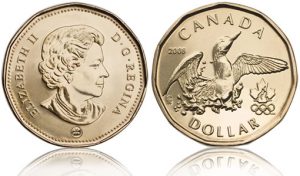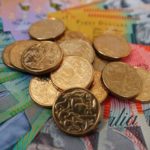 Yesterday’s trade (in GMT terms) saw USD/CAD within the range of 1.3124-1.3241. The pair closed at 1.3218, rising 0.70% compared to Fridays close. It has been the 164th gain in the past 301 trading days and also a fifth consecutive one. The daily high has been the highest level since March 28th, when a high of 1.3286 was registered. The major pair has extended its advance to 2.15% so far during the current month, following a 1.29% slump in June.
Yesterday’s trade (in GMT terms) saw USD/CAD within the range of 1.3124-1.3241. The pair closed at 1.3218, rising 0.70% compared to Fridays close. It has been the 164th gain in the past 301 trading days and also a fifth consecutive one. The daily high has been the highest level since March 28th, when a high of 1.3286 was registered. The major pair has extended its advance to 2.15% so far during the current month, following a 1.29% slump in June.
At 8:00 GMT today USD/CAD was inching down 0.02% on the day to trade at 1.3215. The pair touched a daily high at 1.3232 during early Asian trade, overshooting the daily R1 level, and a daily low at 1.3181 during the late phase of the Asian trading session.
Meanwhile, crude oil futures marked their 85th drop out of the past 156 trading days on July 25th. Oil for September delivery went down as low as $42.97 per barrel and closed at $43.13, losing 2.40% compared to Friday’s close. As of 8:10 GMT today the commodity was shedding 0.60% to trade at $42.87, after going down as low as $42.83 per barrel earlier. The latter has been the lowest price level since April 26th, when a low of $42.50 per barrel was recorded.
On Tuesday USD/CAD trading may be influenced by the following macroeconomic reports as listed below.
Fundamentals
United States
S&P/Case-Schiller Home Price Index
At 13:00 GMT Standard & Poors/Case-Schiller will report on the performance of their House Price Index, which measures the change in values of single-family homes in 20 metropolitan areas across the United States. The report serves as a gauge of the US housing markets health. According to the median estimate by experts, home prices in the 20 areas probably rose 5.6% in May compared to May 2015, following a 5.4% surge in April. If expectations were met, Mays rate of increase would be the sharpest one since January, when home values climbed 5.7% year-on-year. Within a recovering economy, a sharper-than-projected gain in prices will usually have a limited-to-moderate bullish effect on the local currency.
Services PMI by Markit – preliminary reading
Activity in the US sector of services probably increased at a faster rate in July from a month ago, with the corresponding preliminary Purchasing Managers Index coming in at a reading of 52.0, according to the median forecast by experts, from a final 51.4 in June. If expectations were met, this would be the highest PMI level since April, when the gauge came in at 52.8. According to Markit, in June the gauge of new work rose at the fastest rate since the start of the year, while business expectations for next year hit a record low.
The PMI is based on data collected from a representative panel of more than 400 private sector companies, which encompasses industries such as transport and communication, financial intermediaries, business and personal services, computing & IT and hotels & restaurants. Values above the key level of 50.0 indicate predominant optimism (expansion in general activity). In case a faster than-expected expansion in services sector activity is reported, this would have a moderate bullish effect on the US dollar, as services contribute to a considerable portion of the US GDP. The preliminary reading by Markit Economics is due out at 13:45 GMT.
Consumer Confidence Index by the CB
Confidence among consumers in the United States probably lowered in July, with the corresponding index coming in at a reading of 95.8, according to market expectations. In June the gauge was reported at 98.0, or the highest level since October 2015, when a revised up index value of 99.1 was reported.
This indicator measures the level of individuals confidence in the US economic development. It is considered as a leading indicator, as it gives an early insight into consumer spending, which accounts for a major part of the nations GDP.
In case the index fell more than anticipated, this would have a strong bearish effect on the US dollar, as lower confidence suggests a lesser willingness to spend and, respectively, a slower economic growth. The Conference Board research group is to publish the official index reading at 14:00 GMT.
New Home Sales
Sales of new single-family homes probably rose at a monthly rate of 1.6% to the seasonally adjusted annual rate of 560 000 in June, according to market expectations, from 551 000 reported in the preceding month. In May, sales in the Northeast plummeted 33.3% to 34 000, those in the West were 15.6% lower to 124 000, while sales in the South fell 0.9% to 323 000. On the other hand, new home sales in the Midwest rose 12.9% to 70 000 in May.
The median sales price of new houses sold went down as low as USD 290 400 in May, after being at USD 320 200 in the preceding month. The average sales price dropped to USD 358 900 in May from USD 378 200 in April. At the end of the month, the seasonally adjusted estimate of new houses for sale reached 244 000, or a level unseen since September 2009. It represents a supply of 5.3 months at the current sales rate, according to the report by the US Census Bureau.
In case the index showed a better-than-anticipated performance, this would support demand for the US Dollar. The Census Bureau is to report the official figure at 14:00 GMT.
Bond Yield Spread
The yield on Canada’s 2-year government bonds went as high as 0.583% on July 25th, after which it closed at 0.578% to add 1.6 basis points (0.016 percentage point) compared to July 22nd.
Meanwhile, the yield on US 2-year government bonds climbed as high as 0.762% on July 25th, or the highest level since June 23rd (0.787%), after which it fell to 0.760% at the close to add 4.5 basis points (0.045 percentage point) compared to July 22nd.
The spread between 2-year US and 2-year Canadian bond yields, which reflects the flow of funds in a short term, widened to 0.182% on July 25th from 0.145% on July 22nd. The July 25th yield spread has been the highest one since July 12th, when the difference was 0.184%.
Daily, Weekly and Monthly Pivot Levels
By employing the Camarilla calculation method, the daily levels of importance for USD/CAD are presented as follows:
R1 – 1.3229
R2 – 1.3239
R3 (Range Resistance – Sell) – 1.3250
R4 (Long Breakout) – 1.3282
R5 (Breakout Target 1) – 1.3320
R6 (Breakout Target 2) – 1.3336
S1 – 1.3207
S2 – 1.3197
S3 (Range Support – Buy) – 1.3186
S4 (Short Breakout) – 1.3154
S5 (Breakout Target 1) – 1.3116
S6 (Breakout Target 2) – 1.3100
By using the traditional method of calculation, the weekly levels of importance for USD/CAD are presented as follows:
Central Pivot Point – 1.3078
R1 – 1.3234
R2 – 1.3341
R3 – 1.3497
R4 – 1.3652
S1 – 1.2971
S2 – 1.2815
S3 – 1.2708
S4 – 1.2600
In monthly terms, for USD/CAD we have the following pivots:
Central Pivot Point – 1.2907
R1 – 1.3163
R2 – 1.3401
R3 – 1.3657
R4 – 1.3913
S1 – 1.2669
S2 – 1.2413
S3 – 1.2175
S4 – 1.1937





